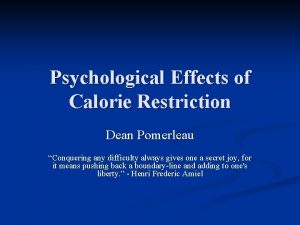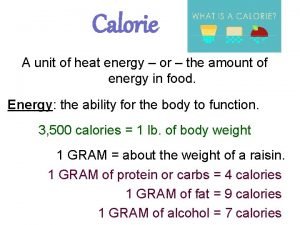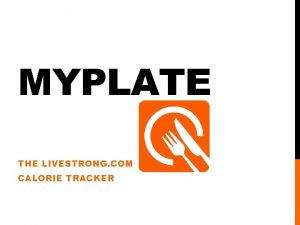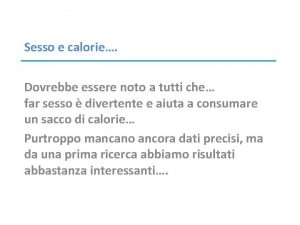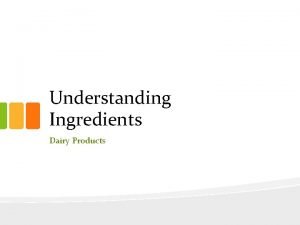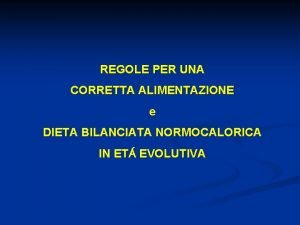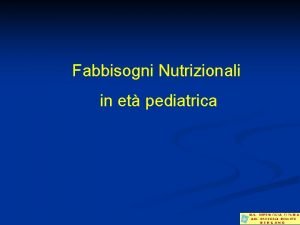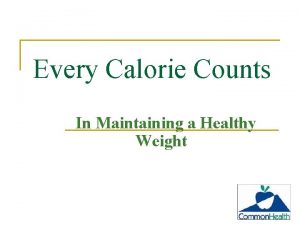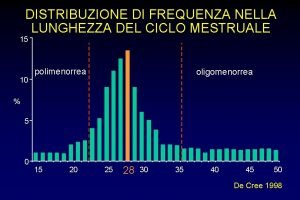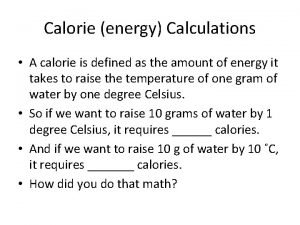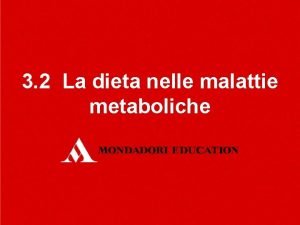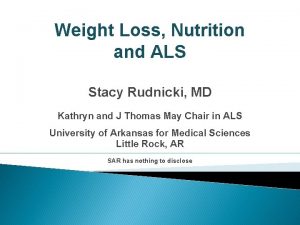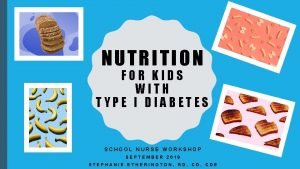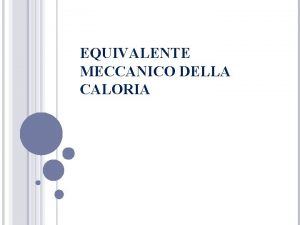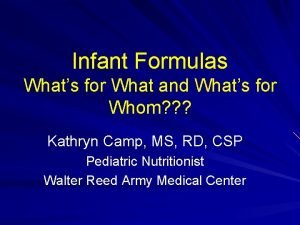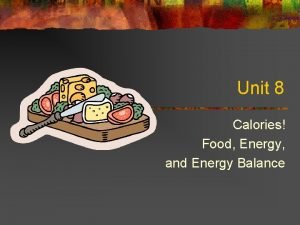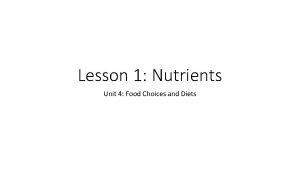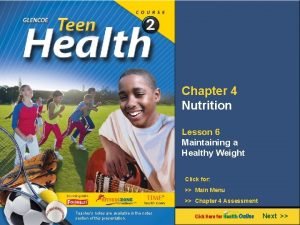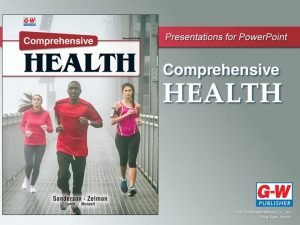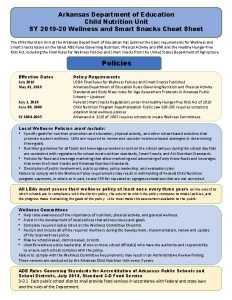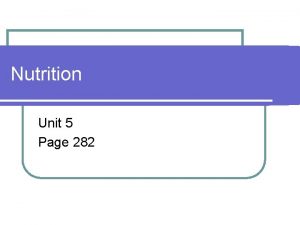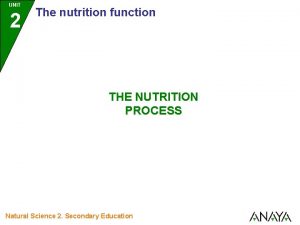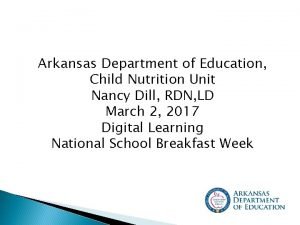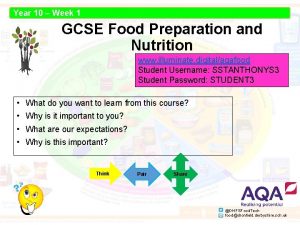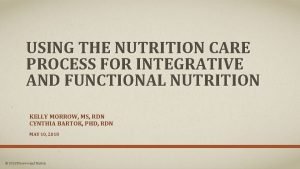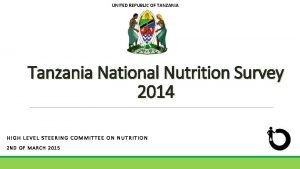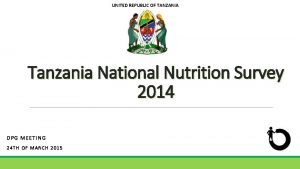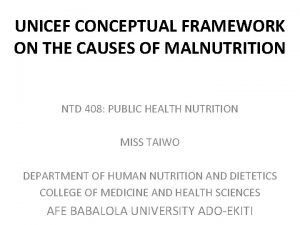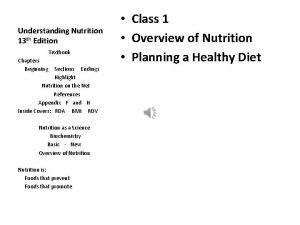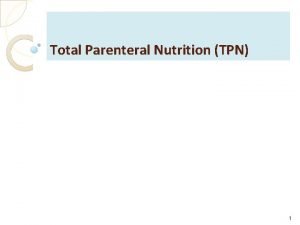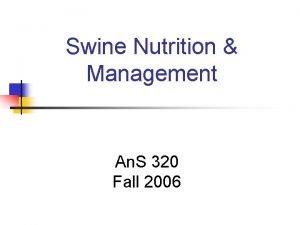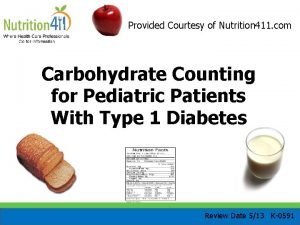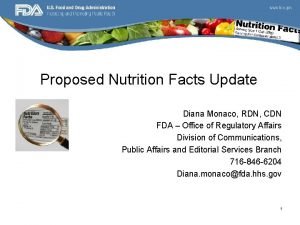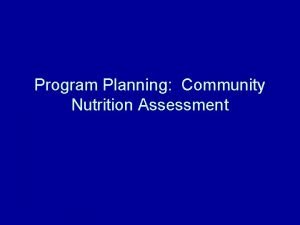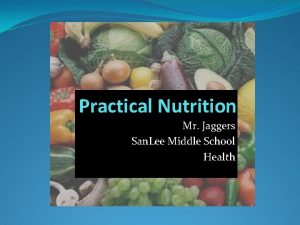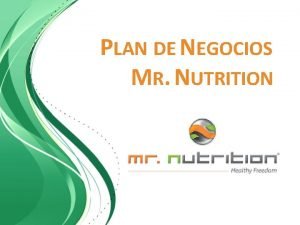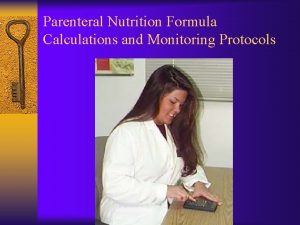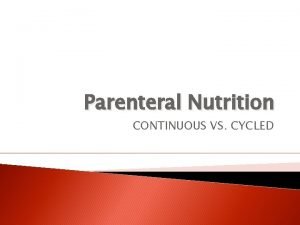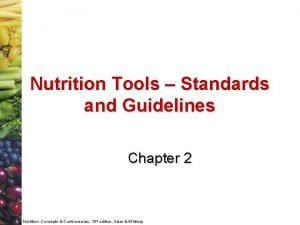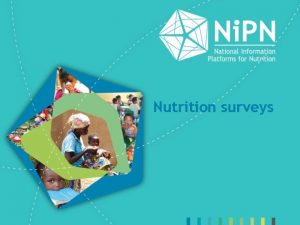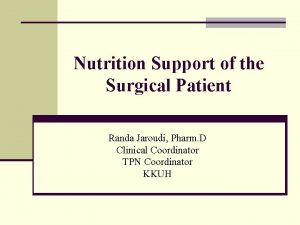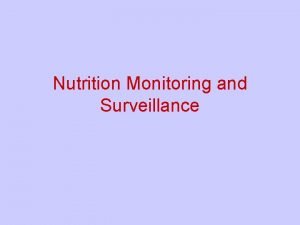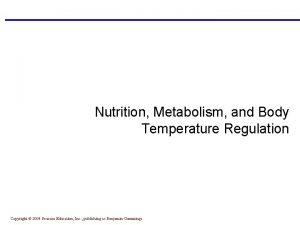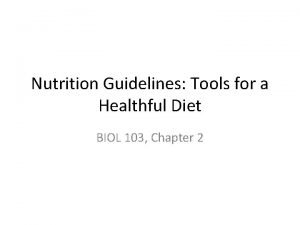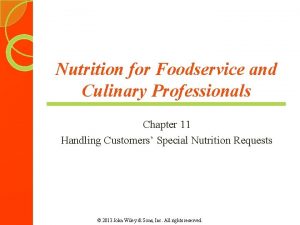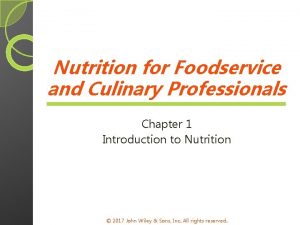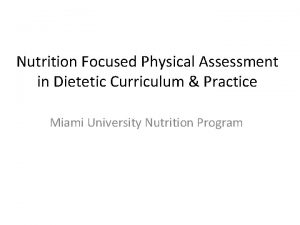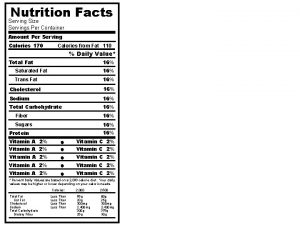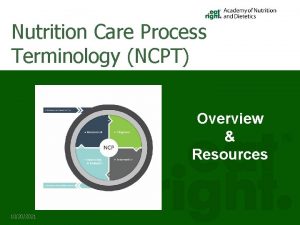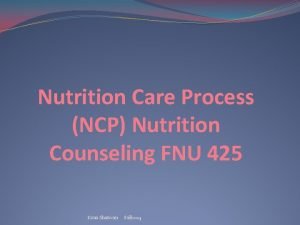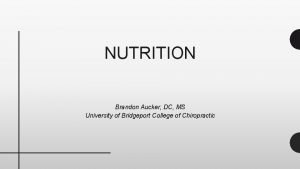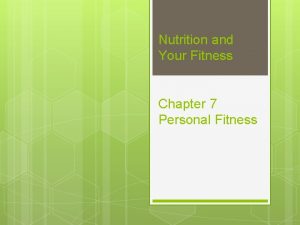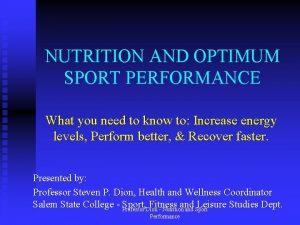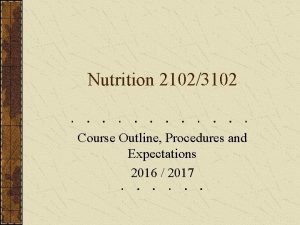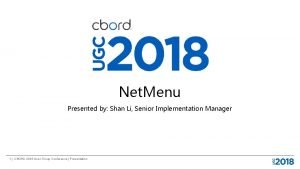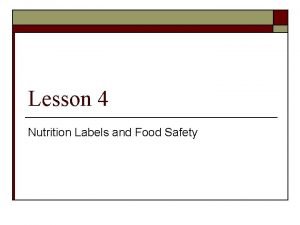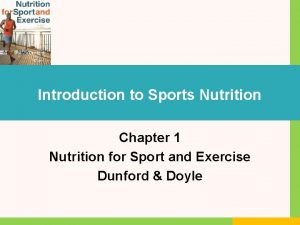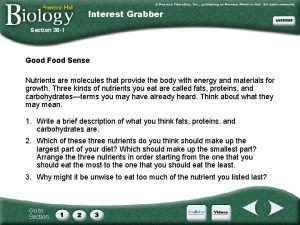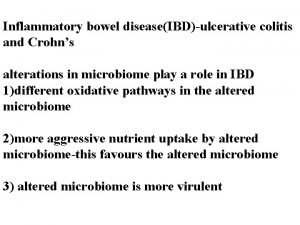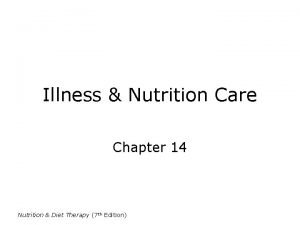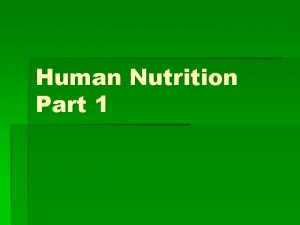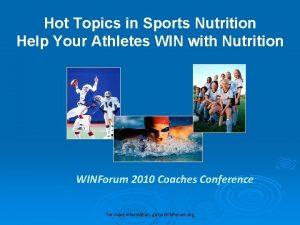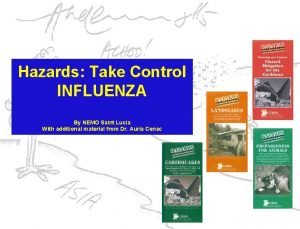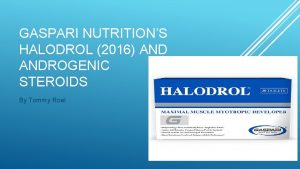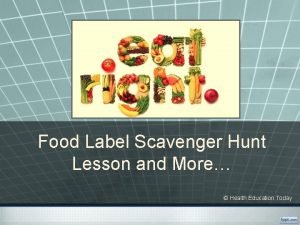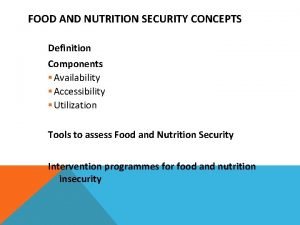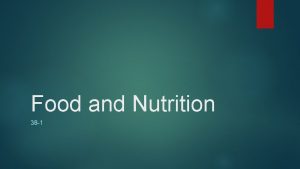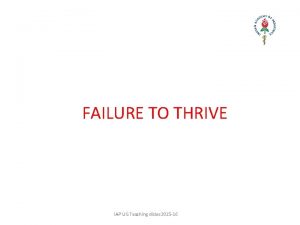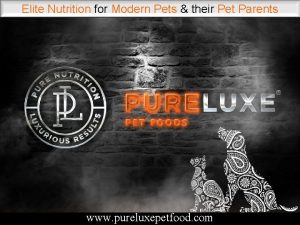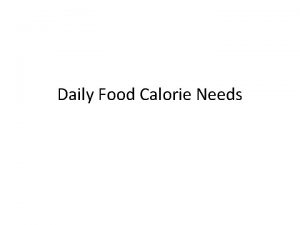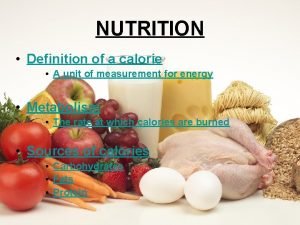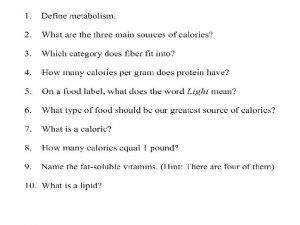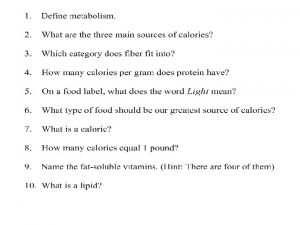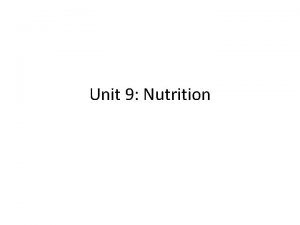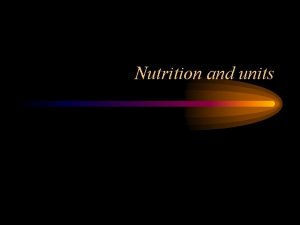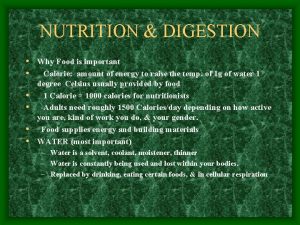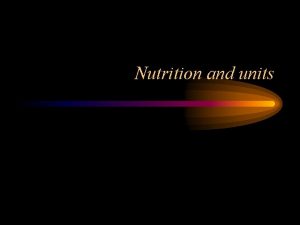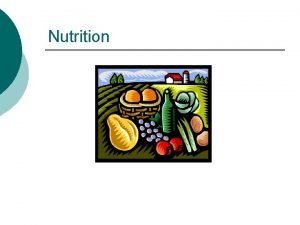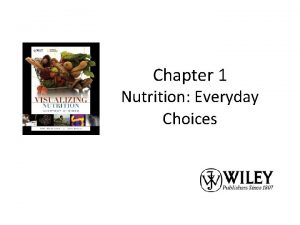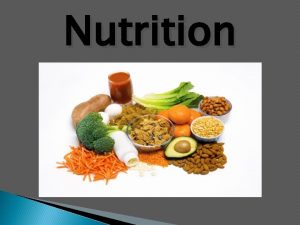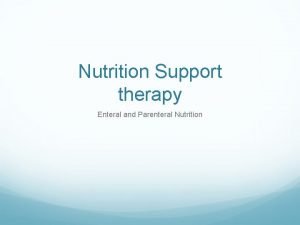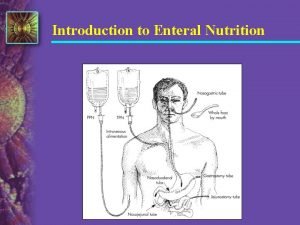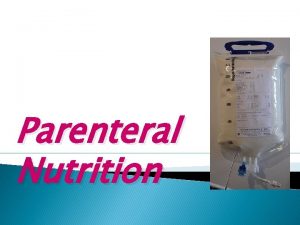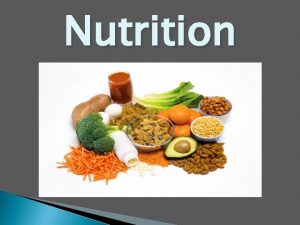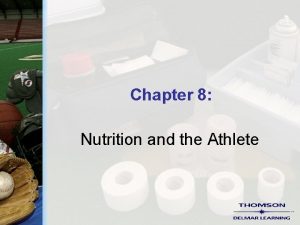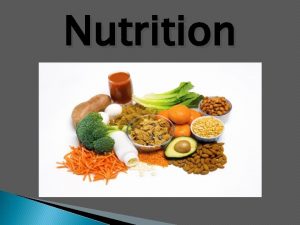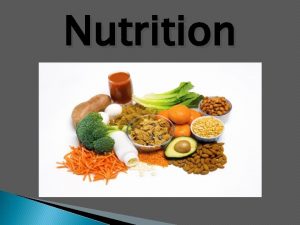Unit 2 Nutrition WHAT IS A CALORIE Calorie






























































































- Slides: 94

Unit 2 Nutrition

WHAT IS A CALORIE? ? • Calorie: The basic measure of energy in food. • The more calories a food has – the more energy it contains • Metabolism: Is the process by which your body breaks down food to release energy as well as the use of energy for the growth and repair of body tissue. • Nutrients: Substances your body needs to regulate functions, promote growth, repair body tissues, and obtain energy.

IMPORTANT TERMS & INFO CONT… RDA- Recommended Daily Allowance FDA – Food & Drug Administration Empty Calorie: a food that contains calories but has little or no nutritional value • Examples: Sodas, Candy • It takes you brain 20 minutes to realize that we have begun eating. • 1 pound (lb) of fat is equal to 3, 500 calories

IMPORTANT TERMS & INFO • How many calories per gram? ? ? • 1 gm Carbs – 4 calories - 15 g carbs = 60 cals • 1 gm Protein – 4 calories - 10 g protein = 40 cals • 1 gm Alcohol – 7 calories • 1 gm Fat – 9 calories - 30 g fats = 270 cals • 1 pound of fat= 3, 500 calories

THE CALORIE EQUATION Maintain Weight: Calories in = Calories Used Gain Weight: Calories in > Calories Used Lose Weight: Calories in < Calories Used

CALORIES, CALORIES Calorie • The more calories a food has, the more energy it contains. How many calories do you use? ▫ Sleeping : 50/hour ▫ Talking on phone: 65/hour ▫ Cleaning : 200/hour ▫ Karate : 365/hour ▫ Jump Rope : 550/hour **Math Time: How many hours of talking on the phone would it take to equal one hour of karate?



WHICH LUNCH WOULD YOU EAT?

Serving Sizes • Helpful Measuring Hints: • • • A fist: one cup (cereals) A handful: 1 -2 ounces (snacks) A thumb (base of tip): one ounce (cheese) Tip of thumb: one teaspoon (spreads) Palm of hand: 3 ounces (chicken, meats) • Americans usually eat 4 -6 oz in one sitting of chips. (almost 5 times the suggested serving size) • Most restaurants size portions are 3 times the amount of a suggested serving size.

6 BASIC NUTRIENTS 1. 2. 3. 4. 5. 6. Carbohydrates Protein Fat Minerals Vitamin Water (breads, pasta) (chicken, seafood) (seeds, oils) (zinc, calcium) (examples: A, D, E, K, B’s, C)

What percent of your diet should come from? This is what everyone Has been taught: This is what we should follow: Carbohydrates: 55 -60% Carbohydrates: 20 -30% Fat: No more than 30% Fats: (The latest science suggests healthy fat) 50 -65% Protein: 10 -15% Protein: 15%

CARBOHYDRATES • Come in 3 varieties: Simple, Complex, Dietary Fiber Two main types: Simple Carbohydrates: ▫ Candy, cookies, sodas, fruit sugars (fructose), milk sugars The body converts all sugars into glucose Complex Carbohydrates: ▫ Starches (pastas), potatoes, grains, rice ▫ Veggies ▫ ** A majority of your carbs should come from veggies and rice. Try to limit grain intake. Grains can be very irritating to the bowls for many and cause excess calorie intake as well with little nutritional value.

CARBOHYDRATES CONT… • Excess glucose can be stored for future use either in the form of FAT or GLYCOGEN. • Glycogen is used as a reserve energy source. • The liver easily converts glycogen to glucose for circulation throughout the body.

Sugar and Artificial Sweeteners ** You Actually Gain Weight by Using Artificial Sweeteners** • Real sugar allows your body to accurately determine that it has received enough calories, thereby activating satiety signaling. • Without the calories, your appetite is activated by the sweet taste of artificial sweeteners, but as your body keeps waiting for the calories to come, sensations of hunger remain

FIBER Where is fiber found? • Tough stringy parts of vegetables, fruits & grains. • Technically, FIBER is NOT a nutrient because it cannot be broken down and absorbed into the bloodstream. Foods that contain fiber? 1. Fruits (especially the skins) 2. Veggies 3. Whole grain products 4. Seeds 5. Beans

FIBER CONT… Why is Fiber so important for our diets? 1. Helps prevent constipation 2. May help reduce the risk of colon cancer 3. May help prevent heart disease Can Fiber be digested? • NO! A food with more than _______ grams of fiber is considered a good fiber source • 3

Fiber

PROTEIN • In our bodies protein can be found in Muscle, Bone, Teeth, Skin, & Blood • Proteins are made up of building blocks called: Amino Acids • Why do we need protein? Most important function is to build and repair body tissue • Sources high in proteins: Fish, Eggs, Chicken, Milk, and Nuts

MORE PROTEIN… Amino Acids ▫ Building blocks of protein ▫ 20 total ▫ 9 “essential” amino acids that must come from your diet/protein – your body can manufacture the rest **Math Time: Which has more protein per ounce: beefsteak or cheddar cheese?

TYPES OF PROTEIN • Complete Proteins ▫ Animal sources: called complete proteins because they contain all the essential amino acids in amounts large enough to meet the body’s needs. • Incomplete Proteins ▫ Plant sources: called incomplete proteins because they are low in one or more essential amino acids.

FATS • The Scientific Name for a fat is a “LIPID” • The two types of Fats are: 1. SATURATED 2. UNSATURATED

SATURATED FATS • Usually solid at room temperature • * has been labeled as “Bad Fat” • Our bodies need saturated fat for many processes of the body: • Provide building blocks for cell membranes, hormones, and hormone-like substances • Mineral absorption, such as calcium • Carriers for important fat-soluble vitamins A, D, E, and K • Help to lower cholesterol levels • Examples: • Animal Fats • Dairy Products

UNSATURATED FATS • Usually liquid at room temperature • Good (in moderation) • Should be consumed cold • Cooked at high heats these fats can cause free radicals and cause cell damage and cancer. • 2 Types: Monounsaturated & Polyunsaturated • Examples:

Why do we need fat on our bodies? 1. Insulation 2. Energy For Muscles 3. Cushions/Pads Organs

GREAT FATS YOU SHOULD BE EATING! • • • Olives/Olive Oil Coconuts/Coconut Oil Butter made from Raw Grass-fed organic milk Raw nuts such as almonds and pecans Organic pastured egg yolks Avocados Grass Fed Meats Palm Oil Unheated organic nut oils

TRANS FATS • Trans Fats are made when manufacturers add hydrogen to the fat molecules in vegetable oils • Food that contain trans fats usually stay fresh longer than saturated fat foods • Bad News: • They have few of the benefits of unsaturated fats • They have many of the negatives of saturated fats • Examples ▫ Margarine ▫ Chips ▫ Commercially Baked Goods (store cookies) • FACT: Trans Fats are now included on Food Labels

CHOLESTEROL • What is it? • A waxy fat-like substance produced in liver of all animals. • We make it, not necessarily part of our diet • When circulating with the blood, deposits called PLAQUE form on walls of blood vessels • Atherosclerosis: hardening of artery wall due to plaque buildup • Too much plaque blocks the blood flow and can lead to a heart attack • Dietary cholesterol (food you eat that contains cholesterol) does not raise your cholesterol level. • Eating foods with trans fats (hydrogenated/partially hydrogenated oils) like processed foods and fried food are responsible for plaque build-up in the arteries.

CHOLESTEROL CONT… • Bad Cholesterol is abbreviated as “LDL” meaning? • LOW DENSITY LIPOPROTEIN • Sticks to walls of blood vessels, which can lead to heart disease • Good Cholesterol is abbreviated as “HDL” meaning? • HIGH DENSITY LIPOPROTEIN • Blood Cholesterol combined should be: • less than 200 mg

Too much cholesterol can: 1. Clog arteries 2. Cause Atherosclerosis

What are 3 things you can do to lower your cholesterol levels? 1. Reduce processed food intake which is high in sugar and trans fats. 2. Reduce trans fat intake 3. Exercise Over time…. plaque that accumulates in the artery walls will cause Atherosclerosis.

Cholesterol • The liver makes cholesterol ▫ The liver makes 800 to 1500 mg of cholesterol everyday, much more cholesterol than in food. ▫ In healthy people the body makes less cholesterol if dietary intake is high, and it makes more cholesterol if dietary intake is low.

VITAMINS • Water Soluble: All of the B’s & C’s • Fat Soluble: A, D, E, K (“all dogs eat kittens”) • What is the difference between water soluble and fat soluble vitamins? • Water – Must be supplied daily or they will be excreted. • Fat – Stored until they are needed. • Can taking large amounts of vitamins be harmful? • YES!!!!

VITAMINS DEFICIENCIES Vitamin Deficiency is called What might happen? Vitamin C “Scurvy” Bleeding Gums & Noses, Tooth loss Vitamin D “Rickets” Weak muscles, delayed tooth development, slow wound healing Vitamin K None Blood may not clot Vitamin A “Night Blindness” From not eating enough A (carrots)

RICKETS




How About Vitamin Overload? Too much: • Vitamin C – faintness, dizziness, fatigue • Vitamin D – nausea, constipation, vomiting • Vitamin A – liver problems, diminished bone density, birth defects

MINERALS • Minerals: Inorganic substances that the body can not manufacture • Trace Minerals: Minerals needed in small amounts

Minerals Deficiency Name/ or what might happen Not enough Calcium **Vitamin D needs to be present in order for our bodies to absorb calcium Osteoporosis Not enough Iron Anemia Not enough Iodine Goiters Too much sodium (salt) can cause High blood pressure Fact: 85% of teenage girls do NOT get enough calcium in their diets

WATER • • • Most important nutrient!!! Your body is made up of 60 – 70% water Girls (age 14 -18) need about 10 (8 oz) cups per day. Boys (same age) need 14 (8 oz) cups per day. You get zero energy (calories) from water Dehydration: a serious reduction of the body’s water content **You can lose 4 cups of water (32 ounces) during every hour of intense exercise **

FUNCTIONS OF WATER 1. Carries nutrients to the cells and transport waste from the cells 2. Lubricates the joints and mucous membranes 3. Enables you to swallow and digest food 4. Absorb Nutrients 5. Eliminate waste • Our bodies use about 10 -girls, 14 -boys cups of water each day!

BENEFITS OF WATER

75% of Americans are chronically dehydrated. (Likely applies to half the world population. ) Water

In 37% of Americans, the thirst mechanism is so weak that it is mistaken for hunger. Water

Even MILD dehydration will slow down one’s metabolism by 3%. Water

Lack of water…the #1 trigger of daytime fatigue. Water

Preliminary research indicates that 8 -10 glasses of water a day could significantly ease back and joint pain for up to 80% of sufferers. Water

A mere 2% drop in body water can trigger fuzzy short-term memory, trouble with basic math, and difficulty focusing on the computer screen or on a printed page. Water

Drinking five glasses of water daily decreases the risk of colon cancer. It can reduce the risk of breast cancer, and one is less likely to develop bladder cancer. Water

Are you drinking the amount of water you should drink every day? Water

Apples An apple a day… That’s 5 oz. of pure water. How about “eating” your water?

Broccoli is about 90% water. How about “eating” your water?

Cucumbers A single cucumber contains almost 10 oz. of water. How about “eating” your water?

Nonfat yogurt For every 8 oz. of yogurt, you’re getting 6. 5 oz. of water How about “eating” your water?

New as of June 2011…My Plate

MY PLATE The website features practical information and tips to help • Americans build healthier diets. • It features selected messages to help consumer focus on key behaviors. – – – Enjoy your food, but eat less. Avoid oversized portions. Make half your plate fruits and vegetables. Switch to fat-free or low-fat (1%) milk. Make at least half your grains whole grains. Compare sodium in foods like soup, bread, and frozen meals— and choose foods with lower numbers. – Drink water instead of sugary drinks. • Choose. My. Plate. gov 1 includes much of the consumer and professional information formerly found on My. Pyramid. gov.

Let’s Eat for the Health of It The 2010 Dietary Guidelines brochure This brochure contains practical strategies to make healthy food choices. The Brochure highlights themes from the Guidelines such as Balancing Calories, Foods to Reduce, and Foods to Increase.

VEGETARIANISM • Vegans: Eat no animal products at all • Ovo-Vegetarians: No animal, but eats eggs • Lacto-Vegetarians: No meat, but dairy products • Ovo-Lacto Vegetarians: No meat, but eats milk & eggs • People may choose a vegetarian lifestyle because of: ▫ ▫ ▫ Religion Treatment of animals Doctor recommended diet

FOOD SENSITIVITIES • Food Allergy: The body’s immune system overreacts to substances (proteins) in foods. • Common foods that cause allergies: 1. Peanuts or other nuts 2. Eggs 3. Milk • Food Intolerance: • An inability to digest a particular food or food additive • Common foods: 1. Milk Products 2. Chocolate 3. Wheat • More common than food allergies • How do people get them? • Can be born with it or grow into or out of them.

DIETING Fad Diets ▫ Are popular diets that may help a person lose weight but without proper regard for nutrition. ▫ Examples: Liquid Diets High Protein Cabbage Diet

Examples of Fad Diets Liquid Diets • Examples: Slim Fast / Nestles Sweet Success • Replace 2 meals per day / a shake and eat 1 balanced meal • Pros: convenience and get nutrients from shakes • Cons: not much variety, stay on it or weight will return

EXAMPLES OF FAD DIETS High Protein • Examples: Dr. Atkins, Protein Power Plan, The Zone • Cut out carbs and eat all protein and fat (only cheese, meat & seafood) • Pros: Quick loss, can eat desirable foods, and can eat at restaurants with little modification. • Cons: Can’t eat “on the go”, can be expensive, and foods tend to be high in saturated fats.

EXAMPLES OF FAD DIETS Cabbage Diets • Sheds water weight by consuming cabbage, soup, or small portions of other specific foods. • Pros: short, sheds water weight quickly • Cons: very strict, weight doesn’t stay off, soup taste and smell is unappealing to many

FAD DIETS • Why don’t fad diets work? • They are not LIFESTYLE CHANGES • What are some healthy ways to lose weight & cut calories 1. Recognize Eating Patterns (record & analyze what you eat) 2. Plan Helpful Strategies (see next slide) 3. Exercise (cutting calories without exercise can just lower your metabolism) 4. Read labels (fat free doesn’t mean get skinny)


Did You Know • –Tthe reason you are hungry after a large meal the night before is because that meal makes your system work over-time, raising your blood sugar. • Once your meal is digested – usually while you sleep – your blood sugar drops, triggering greater secretions of insulin, which further gives you the early morning hungries.

FOOD SAFETY • Foodborne Illness: Results from consuming a food or drink that contains either a poison or disease-causing micro-organism • Bacteria and Viruses cause the most common foodborne illnesses • Examples: E. coli, Salmonella • How does it usually spread? 1. When food is undercooked 2. When raw food touches cooked food 3. When people preparing food transfers the microorganisms onto their hands, countertops, or utensils • AVOID CROSS-CONTAMINATION

FOOD POISONING • Salmonella • Often found in poultry & eggs • Cook all foods that contain eggs (even cookie dough ) • E. coli • Can live in beef • Prevention: properly cook meat, refrigerate properly • Botulism • Very serious and deadly • Can live in canned food • Look for swollen or dented cans

IS IT SAFE? 1. Your mom is fixing burgers and she takes the burgers out to the grill and brings them in on the same plate once cooked. NO – Cross Contamination 2. At home you grab a dented, bulging, or swollen canned good…. NO – Botulism 3. If a portion of bread is molding is it OK to cut off the mold and eat the rest of the bread? NO – bread is very porous. If there is mold on a part, there are spores throughout. 4. It is recommended that you wash your hands with soap for 20 seconds? YES – taking your time when washing your hands is important 5. Hot dogs that have been stored unopened in the refrigerator for over 7 days. YES – unopened, means no air borne contaminates & refrigeration prevents the growth of bacteria

IS IT SAFE? 6. A bruised piece of fruit. YES – bruising is not mean the whole thing is bad 7. Frozen ham that was thawed on the counter. NO! exposing it to room temperature for a long period of time, even unopened allows bacteria already present to multiply rapidly. Thaw in fridge or microwave! 8. Meat loaf that’s pink in the middle after cooking. NO – pink or blood usually means it is not cooked long enough 9. Is it OK to cut raw vegetables on the same cutting board after you’ve cut raw chicken? No – Cross Contamination 10. You sneeze, you have an open cut, or your hair gets into the food, can this contribute to food-borne illnesses? No - Contamination

Health Stats: What health trend do these statistics reveal? What changes might help reverse this trend? How successful do you think the changes would be?

DIET AND NUTRITION FACTS FROM THE AMERICAN DIETETIC ASSOCIATION: • Americans spend over 40 Billion Dollars per year on Diet and Fitness Related Products • 80% of American Women are on Diets • 45% of Teen Girls think they are overweight and need to diet when they really are not • About 90% of all Diet Plans DO NOT WORK! • The average American woman actually wears a size 12 to 14 • Women need a fat level of approximately 22% of their body weight in order for their body to menstruate normally

Myth Eating disorders affect only females. Fact Eating disorders affect females more than males, but males do develop eating disorders. Because of this myth males are even less likely than females to seek help for an eating disorder. What factors other than gender might keep someone from seeking help for an eating disorder?

EATING DISORDERS • A mental disorder that reveals itself through abnormal behaviors related to food • 2 Main Types ▫ Anorexia Nervosa When a person does not eat enough food to maintain a healthy weight ▫ Bulimia When a person has uncontrolled eating binges(consuming a large amount of calories in a short time) followed by purging (vomiting).

ANOREXIA NERVOSA • What things may lead to this disorder? ▫ ▫ Outside pressures High expectations The need to achieve The need to be accepted • Typical Behaviors 1. Extremely low caloric intake 2. Obsession with exercise 3. Emotional problems 4. Unnatural interest in food 5. Distorted body image 6. Denial of problem

ANOREXIA CONTINUED… What physical symptoms may occur? 1. 2. 3. 4. 5. 6. 7. 8. Extreme weight loss Constipation Hormonal changes Heart damage Impaired immune function Lower heart rate Menstrual cycle stops Can result in death

Eating Disorders • Bulimia Nervosa: Cycles of overeating (bingeing) are followed by cycles of clearing digestive tract (purging). Many Bulimics will follow a restrictive diet between these cycles. • Bingeing or Binge eating: is eating large amounts of food in one sitting. • Purging: a behavior that involves self-induced vomiting or misusing laxatives to rid the body of food. • In some extreme cases a person will Bulimia can consume as many as 20, 000 calories in binges that last as long as 8 hours.

Bulimia Typical Behaviors 1. Unable to control eating binges 2. Eating too much food too quickly 3. Eating in private 4. Cycles of weight gain and loss 5. Bathroom visits right after eating 6. Hoarding or storing food

Bulimia Continued Physical Symptoms • Vomiting leads to: • Dehydration • Kidney damage • Irregular heartbeat • Eroded tooth enamel / decay • Damage tissues in stomach / throat mouth • Laxative abuse can lead to damage of blood composition • Laxative abuse interferes with nutrients absorbing into system • Death

BINGE EATING DISORDER • People with binge eating disorder regularly have an uncontrollable urge to eat large amounts of food. • They usually do not purge after a binge. Treatment • People with binge eating disorder need help in learning how to control their eating. • They often need to address underlying emotional problems.

How Thin is Too Thin? ? ?

How Thin is Too Thin? ? ?

How Thin is Too Thin? ? ?

How Thin is Too Thin? ? ?

How Thin is Too Thin? ? ?

How Thin is Too Thin? ? ?

How Thin is Too Thin? ? ? KATE BOSWORTH

How Thin is Too Thin? ? ? NICOLE RICHIE

How Thin is Too Thin? ? ? DEMI MOORE

How Thin is Too Thin? ? ? KEIRA KNIGHTLEY

How Thin is Too Thin? ? ? VICTORIA 'POSH' BECKHAM

THE END!
 Cronies calorie restriction
Cronies calorie restriction Différence entre calorie et kilocalorie
Différence entre calorie et kilocalorie Orange caloriea
Orange caloriea Myplate livestrong
Myplate livestrong Composition dragibus
Composition dragibus Calorie sesso
Calorie sesso Tiramisu light calorie
Tiramisu light calorie Esempio di dieta bilanciata
Esempio di dieta bilanciata Calorie restriction
Calorie restriction Noci calorie
Noci calorie Laf nutrizione
Laf nutrizione Every calorie counts
Every calorie counts Oligomenorrea
Oligomenorrea Carboidrati giornalieri
Carboidrati giornalieri Calorie is defined as
Calorie is defined as Dieta per menopausa 1200 calorie
Dieta per menopausa 1200 calorie Harris-benedict -basal metabolic rate calorie calc
Harris-benedict -basal metabolic rate calorie calc Diet chart for diabetic patient
Diet chart for diabetic patient Equivalente meccanico della caloria
Equivalente meccanico della caloria Enfamil gentlease 22 calorie formula recipe
Enfamil gentlease 22 calorie formula recipe Fluxo de calor
Fluxo de calor Unit 10, unit 10 review tests, unit 10 general test
Unit 10, unit 10 review tests, unit 10 general test Biobeyond unit 8 nutrition lab counting calories
Biobeyond unit 8 nutrition lab counting calories Food and nutrition unit 4
Food and nutrition unit 4 Rda food label
Rda food label Unit 3 nutrition lesson 6 anorexia nervosa and bulimia
Unit 3 nutrition lesson 6 anorexia nervosa and bulimia Unit 3 nutrition lesson 4 weight control
Unit 3 nutrition lesson 4 weight control Arkansas child nutrition unit
Arkansas child nutrition unit Agriscience unit 26 self evaluation answers
Agriscience unit 26 self evaluation answers Food and nutrition unit 5
Food and nutrition unit 5 Nutrition unit 2
Nutrition unit 2 Arkansas department of education child nutrition unit
Arkansas department of education child nutrition unit Unit 26 animal anatomy physiology and nutrition
Unit 26 animal anatomy physiology and nutrition Suatu lembaga yang
Suatu lembaga yang Hyp opp adj triangle
Hyp opp adj triangle English unit conversion
English unit conversion Algebra 2 unit test
Algebra 2 unit test Contoh soal perhitungan unit cost rumah sakit
Contoh soal perhitungan unit cost rumah sakit Unit process and unit operation
Unit process and unit operation Unit operation and unit process
Unit operation and unit process Setiap unit akuntansi dianggap sebagai unit yang mandiri
Setiap unit akuntansi dianggap sebagai unit yang mandiri Gcse food tech high skill dishes
Gcse food tech high skill dishes Nutrition care process
Nutrition care process Tanzania national nutrition survey 2020
Tanzania national nutrition survey 2020 Tanzania national nutrition survey 2018
Tanzania national nutrition survey 2018 Unicef framework for causes of malnutrition
Unicef framework for causes of malnutrition Understanding nutrition 13th edition rental
Understanding nutrition 13th edition rental Tpn injection
Tpn injection Swine nutrition management
Swine nutrition management Specialized nutritional support
Specialized nutritional support Nutrition 411
Nutrition 411 Monaco drink nutrition label
Monaco drink nutrition label Community nutrition assessment
Community nutrition assessment Astaxanthin benefits
Astaxanthin benefits Jaggers nutrition
Jaggers nutrition Mr nutricion
Mr nutricion Calculating parenteral nutrition
Calculating parenteral nutrition Tpn tapering guidelines
Tpn tapering guidelines Discretionary calories
Discretionary calories Types of nutritional survey
Types of nutritional survey Complication of parenteral nutrition
Complication of parenteral nutrition Nutrition words
Nutrition words Nutrition monitoring definition
Nutrition monitoring definition Nutrition metabolism and body temperature regulation
Nutrition metabolism and body temperature regulation Learning outcomes of nutrition in plants
Learning outcomes of nutrition in plants Ul tolerable upper intake level
Ul tolerable upper intake level Chapter 11 culinary nutrition
Chapter 11 culinary nutrition Nutrition for foodservice and culinary professionals
Nutrition for foodservice and culinary professionals Nutrition focused physical exam training
Nutrition focused physical exam training Focused gi assessment
Focused gi assessment 6 servings per container
6 servings per container Nutrition care process terminology
Nutrition care process terminology Diabetes pes statement
Diabetes pes statement Ncp nutrition care process
Ncp nutrition care process University of bridgeport nutrition
University of bridgeport nutrition Kelsey carbonetta
Kelsey carbonetta Optimum sports performance
Optimum sports performance Nutrition 3102
Nutrition 3102 Netmenu cbord
Netmenu cbord Human nutrition grade 11
Human nutrition grade 11 Lesson 4 nutrition labels and food safety
Lesson 4 nutrition labels and food safety Introduction to sports nutrition
Introduction to sports nutrition 38-2 the process of digestion
38-2 the process of digestion Types of parenteral nutrition
Types of parenteral nutrition Soap nutrition
Soap nutrition Stages of human nutrition
Stages of human nutrition Sports nutrition topics
Sports nutrition topics Nemo 3a nutrition
Nemo 3a nutrition Rich gaspari steroids
Rich gaspari steroids Diabetes statistics scavenger hunt answer key
Diabetes statistics scavenger hunt answer key Nutrition security meaning
Nutrition security meaning Section 38-1 food and nutrition
Section 38-1 food and nutrition Iap teaching slides nutrition
Iap teaching slides nutrition Extroidinairre
Extroidinairre High performance nutrition
High performance nutrition
